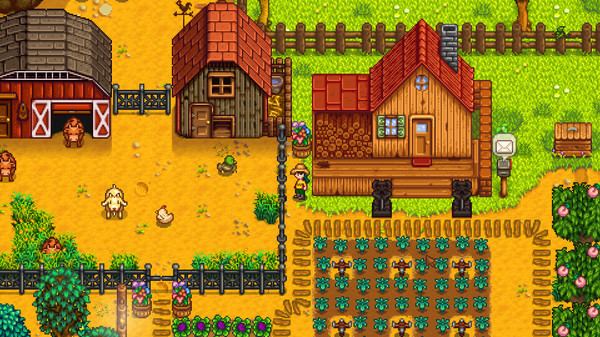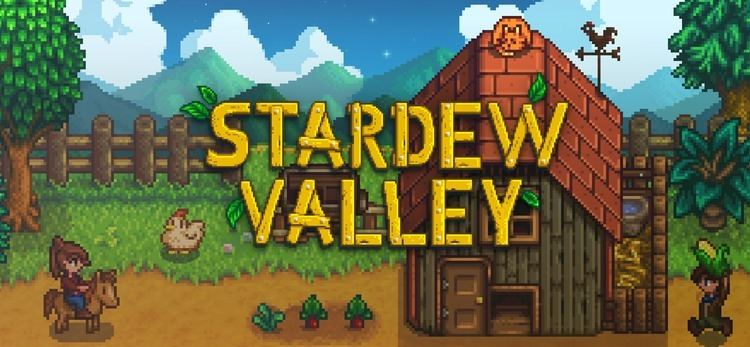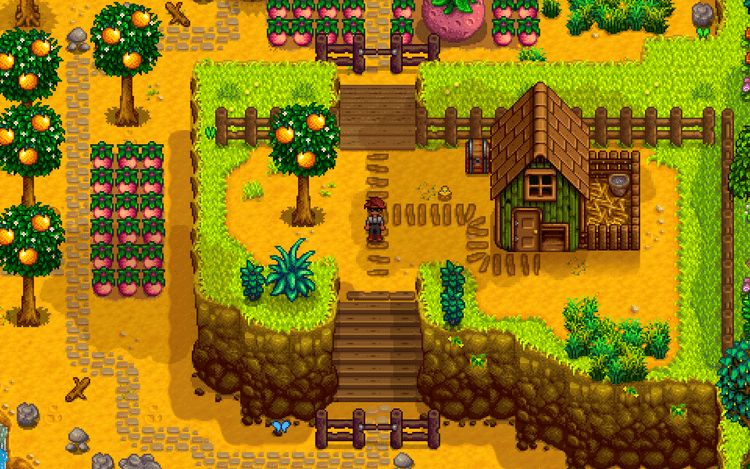9.4 /10 1 Votes9.4
8.8/10 IGN Artist(s) Eric Barone Engine XNA Initial release date 26 February 2016 Designer Eric Barone | 10/10 Steam Programmer(s) Eric Barone Composer(s) Eric Barone Mode(s) Single-player Developer Eric Barone | |||||||||||||||||||||||||||||||||
 | ||||||||||||||||||||||||||||||||||
Platforms PlayStation 4, Xbox One, Nintendo Switch, Microsoft Windows, Macintosh operating systems, Linux, macOS Similar Starbound, Terraria, Firewatch, Hyper Light Drifter, Harvest Moon | ||||||||||||||||||||||||||||||||||
Stardew valley trailer
Stardew Valley is an indie farming simulation role-playing video game developed solely by Eric Barone and published by Chucklefish Games. The game was released for Microsoft Windows in February 2016, with ports for OS X, Linux, PlayStation 4 and Xbox One released later that year. A port for Nintendo Switch is also in development and is expected to be released in 2017. In Stardew Valley, the player takes the role of a character that, to get away from the hustle of an office job, takes over their grandfather's dilapidated farm in a place known as Stardew Valley. The player manages their character's time and energy levels as they clear land, plant and tend crops, raise livestock, craft goods, mine for ores, and engage in social activities, including romances leading towards marriage, with the various residents of the small town, all while earning in-game money to expand their farm. The game is open-ended, allowing the player to take on activities as they see fit.
Contents

Stardew Valley was heavily inspired by the Harvest Moon video game series, with additions by Stardew Valley's sole designer, Eric Barone, to address some of the shortcomings of these games while using the opportunity as an exercise to improve his own programming and game design skills. Barone developed the title on his own over four years and interacted frequently with players who were interested in the title to get feedback. Chucklefish Games approached Barone midway through development with the offer to publish the title, allowing him to focus more on completing the game.

Stardew Valley received positive reception from critics upon release, and was one of the highest-selling titles on Steam in the first few months of its release, eventually selling over one million copies. Barone plans to expand the game to include co-operative play and support for other platforms, among other features.

Stardew valley in 15 seconds
Gameplay

Stardew Valley is a farming simulation game primarily inspired by the Harvest Moon video game series. At the start of the game, the player creates their character, with them becoming the recipient of a plot of land and a small house once owned by their grandfather in a small town called Stardew Valley. The player may select one of five farm maps (introduced in version 1.1) according to their preference in play style, such as one with extra foraging opportunities, one with more mining resources, and another with a fishing river. The farm plot is initially overrun with boulders, trees, stumps, and weeds, and the player must work to clear them in order to restart the farm, tending to crops and livestock so as to generate revenue and further expand the farm's buildings and facilities.
The player may also interact with non-player characters (NPC) that inhabit the town, including engaging in relationships with these characters; this can culminate in marriage, which results in the NPC helping the player's character to tend the farm. The player can also engage in fishing, cooking, and crafting, and also explore procedurally-generated caves with materials and ores to mine or battle creatures within. The player can take on various quests to earn additional money, or work at completing specific collections of materials offered at the town's Community Center to gain additional rewards. All of these activities must be metered against the character's current health, exhaustion level, and the game's internal clock. If the character becomes too exhausted, they will be returned to their house and restored with energy on the morning of the next day, but having forgone any opportunities to continue in activities from the previous day. If the player loses too much health, they will lose most of their energy and a random amount of money and items. The game uses a simplified calendar, each year having only four 28-day months that represent each season, which determines which crops can be grown and which activities can be beneficial. The character is evaluated on their third year. There is otherwise no deadline for completing the game, and as of 1.1 the player can be re-evaluated.
Development
Stardew Valley was created by American indie game designer Eric Barone, under the alias of ConcernedApe. In 2011, Barone had graduated from the University of Washington Tacoma with a computer science degree, but had not been able to get a job in the industry, instead working as an usher at the Paramount Theatre in Seattle. Looking to improve his computer skills for better job prospects, he came to the idea of crafting a game which would also pull in his artistic side. Stardew Valley originally began as a modern fan-made alternative to the Harvest Moon series, as he felt that "the series had gotten progressively worse after Harvest Moon: Back to Nature". Unable to find a satisfactory replacement, Barone began to create a game similar to the series, stating that his intent was "to address the problems I had with Harvest Moon" and that "no title in the series ever brought it all together in a perfect way". Barone was also inspired by other games, including Animal Crossing, Rune Factory, Minecraft, and Terraria, adding features seen in those titles such as crafting, quests, and combat.
Initially, Barone considered releasing the title on Xbox Live Indie Games due to the ease of publishing on that platform, but found early on that his scope for the game shifted to be much larger than originally anticipated. Barone publicly announced the game in September 2012, using Steam's Greenlight system to gauge interest on the game. After the title was shown a great deal of support from the community, Barone began working on the title in full, engaging with Reddit and Twitter communities to discuss his progress and gain feedback on proposed additions. He was approached by Finn Brice, director of Chucklefish Games, shortly after the Greenlight period in 2013, who offered to help publish the game on release. Chucklefish took over many of the non-development activities for Barone, such as site hosting and setting up his development wiki. Barone considered the timing of Chucklefish's involvement fortunate, as Barone was hesitant about using Steam's Early Access system for development. Barone spent four years working on the project, redoing it multiple times, and was the sole developer on the game, frequently spending 10 hours or more a day working on it. He programmed it in C# using the Microsoft XNA framework, while also creating all of the game's pixel art and musical pieces.
Barone aimed to give the player the feeling of immersion in a small farming community, stating that he wanted Stardew Valley to be a fun game, while also wanting it "to have real-world messages". In contrast to the Harvest Moon games, which could end after two years of in-game time has passed, Barone kept Stardew Valley open-ended so that players would not feel rushed to try to complete everything possible. During development, Barone recognized that some players would attempt to figure out mechanically how to maximize their farm's yield and profit through spreadsheets and other tools, but hoped that most players would take the time to learn these on their own. To that end, he designed the cooking aspect of the game purposely to not be profitable, but instead pay back in bonuses that aided exploration, farming, mining and fishing skills. Barone also opted to not include the butchering of farm animals for meat products, encouraging the player to name and tend to each animal individually in staying with the feeling he wanted for the game. The animals cannot die but, if not tended to, stop producing products.
In April 2015, Barone announced he intended to release the game only once he felt it was feature complete, refusing to put the game onto the Early Access program, or accept any pre-sale payments. The game was released for Microsoft Windows on February 26, 2016. Following its release, Barone continued to work on the game, taking feedback from the community and patching bugs, and stated plans to add in additional features at a later date. Barone anticipated adding in more end-game content, support for user modifications, and console releases. Barone had stated that he initially planned a four-player cooperative mode to be released in the game at launch, which instead was pushed to a future update. In this mode, Barone planned that all players would share a common farm, enabling players to all do different tasks related to it, such as one player mining while others tend to different parts of the farm.
In May 2016, Barone announced that Chucklefish would help with non-English localizations, OS X, Linux, and console ports, and the technical aspects required for online co-operative play, allowing him to focus solely on the first major content update. The OS X and Linux ports were released on July 29, 2016. The Xbox One port was announced during Microsoft's press conference at the Electronic Entertainment Expo 2016 in June 2016; Barone further stated that ports for the PlayStation 4 and Wii U were also in development, with all three planned for release in Q4 2016. The PlayStation 4 and Xbox One versions were released on December 13, 2016, and on December 14, 2016 respectively. Barone announced in November 2016 that he has opted to transfer efforts from the Wii U version to a port for the Nintendo Switch, citing his evaluation of the current gaming landscape. The Switch port is expected to be released in mid-2017, and will be the first console version to include the planned co-operative multiplayer mode, though it will not launch with it.
Barone has also started investigating the possibility of a PlayStation Vita port, but has not yet committed to this platform.
505 Games will publish and distribute retail versions of Stardew Valley for the PlayStation 4 and Xbox One, to be released in April 2017. In addition to the game, the version will include a new map, a redemption code to download the soundtrack, and a small guide book for the game.
Reception
Stardew Valley received generally favorable reviews, according to review aggregator Metacritic. Jesse Singal writing for the Boston Globe wrote that the game was "utterly compelling, lovingly crafted", and provided the player with numerous varieties of activities to do without falling into a cycle of repetitive activities. Elise Favis of Game Informer found that watching her autistic brother play Stardew Valley helped her to understand his condition better, as the game provides enough structure of present events with enough of a view of future events to allow her brother to enjoy the game.
In the first two months after its release, Stardew Valley was one of the best-selling games on Steam, selling over 400,000 copies across Steam and GOG.com in two weeks, and by early April, more than 1 million copies had been sold. Valve reported that Stardew Valley was in the top 24 revenue-generating games on Steam during 2016. Journalists noted that the gaming community had shown support for Barone for the game; while there have been some players that have obtained the game illegally, these players have been impressed with the game and stated they plan to purchase the game, while other players have made offers to help pay for those that can't afford the game. Stardew Valley has also seen an active modding community, with players creating additional features and texture replacements for the game.
Yasuhiro Wada, the creator of the Harvest Moon series that Stardew Valley was inspired by, stated that he was "very happy" with the game, as it has shown to him that Harvest Moon was not a forgotten series and continued on in spirit. He also stated that the approach taken by Barone with Stardew Valley was able to retain the freedom that he had wanted to keep in the Harvest Moon series that had been lost in the latter games, with more focus on animation and graphics. Gamasutra named Barone one of the top ten developers for 2016, identifying that he had "single-handedly" developed something that "breathed new life into a genre", otherwise dominated by the Harvest Moon series. Forbes named Barone one of their "30 Under 30" persons to watch in the area of gaming for 2017, citing his time and commitment towards making Stardew Valley a success.
